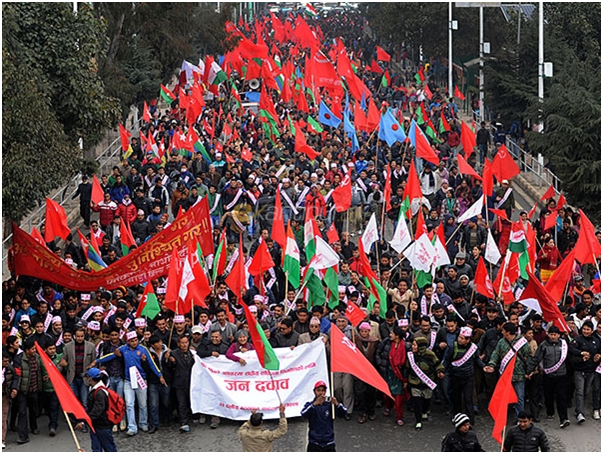Nepal Constitution Under the Shadow of the Military
Nepal has been agitating for the Constitution under different banners since 2006.

NEW DELHI: Over a week has passed since seven policemen and an infant were killed during a Tharu agitation in Tikapur in Nepal. It was followed by riots and army deployment in the area. After 10 years the Nepalese Army is out of the barracks to enforce law and order.
Although Nepal today is a Republic, not a bit seems to have changed in the government’s approach towards crisis in Nepal. It’s still looking south for direction. Instead of making a serious effort to reach out to disgruntled groups the Nepal government seems to be in a hurry to promulgate the Constitution in ‘time’ under the military’s shadow. Suddenly extended Constituent Assembly sittings are being held.
The proposed constitution has opened old wounds which have bled Nepal since the 1950s. Lack of foresight coupled with superficial attempts to resolve it has, like always, only deepened the crisis. The standard crisis management method so far has been: first, suppress democratic aspirations, then negotiate and at the end create a bigger problem to make the first look minor or at least unworthy of any serious attention.
Just a brief recall: to counter parliamentarians, erstwhile King Birendra let the Maoists spread through the country, and even held secret talks with them. Later to control the Maoists, King Gyanendra held secret negotiations with China and other European countries and gave them full opportunity to influence Nepal’s internal politics. Then, to make the King listen, the parliamentary parties struck a deal with the Maoists. And in 2006, to subdue the Maoists, the Nepal government under late GP Koirala extended support to the Madhesi Movement.
The current crisis in Nepal too is the result of a lack of wisdom, and levels of connivance, in the current leadership of the ruling parties. In the last three months the Nepali politicians have made two fundamental errors which have fueled mass unrest. First, arose from the belief that the leaders of the United Communist Party of Nepal (Maoists) and Bijaya Kumar Gachhadar of the Madhesi Janadhikar Forum, Democratic still hold credibility in their constituencies. Second, they couldn’t correctly foresee the people’s anger. They believed that with the Maoists and the Forum on their side they would make people accept the constitution without much trouble.
It is a fact that the second Constituent Assembly is hardly as representative of the will of Nepalese people as was the first. The representation of indigenous, Madhesi and dalits-minority has almost come to naught in the present Constituent Assembly. It is definitely a setback.
The parties which had been ruling Nepal for last three decades and were by large responsible for whatever Nepal is today, are in the majority and have forcibly revised several important decisions of the previous Assembly. The unrest today is a result of those revisions. Along with this the Maoists also completely capitulated on every positive issue they once stood for. Such as secularism, ethnic based federalism and land reform. In all, the 2nd Constituent Assembly has given a constitution minus the spirit of the 2006 Comprehensive Peace Agreement and several other agreements and understandings with the Madhesi and other ethnic and poor people of Nepal. In fact, it gave the same constitution which had been proven outdated for Nepal long ago.
Hence, when the ruling government of the Congress and UML bet on Prachanda and Gachhadar to make people believe their intentions they made a very poor choice. Prachanda and Gachhadar have long lost their credibility. The Madhesi people don’t see Gachhadar as their representative leader. Similarly, Prachanda too doesn’t have the support of people beyond a tiny faction in and outside his party. The parties should have considered the fact that Prachanda lost the election from Kathmandu and marginally won from Siraha. It is only a ‘miracle’ that for the last three years he is at the helm of the UCPNM leadership. For long he has managed to remain at the top only as a compromised choice of rival factions in the party. Both Gachhadar and Prachanda are the leaders who everyone in their parties want to see fail. Their failure guarantees survival as well as resurrection of many other leaders.
Hence, the stamp of these two leaders on the new constitution was not acceptable. Their agreement on the draft only justified people’s fear that they were about to be fooled once again. The result: for the last two weeks Nepal is shut. Curfew is imposed in several parts and gradually the military is taking the lead role. Can a constitution promulgated in this situation give the lasting peace Nepal has been looking for since the 1950s?



